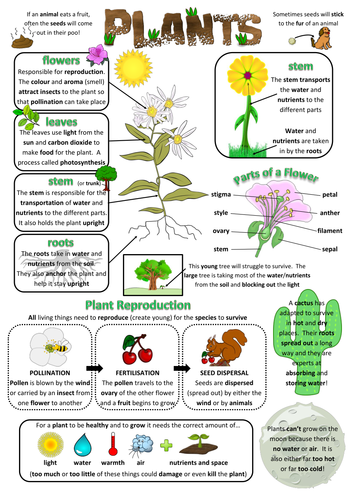







Objectives covered:
Identify and describe the functions of different parts of flowering plants: roots, stem/trunk, leaves and flowers
Explore the requirements of plants for life and growth (air, light, water, nutrients from soil, and room to grow) and how they vary from plant to plant
Investigate the way in which water is transported within plants
Explore the part that flowers play in the life cycle of flowering plants, including pollination, seed formation and seed dispersal
Identify that animals, including humans, need the right types and amount of nutrition, and that they cannot make their own food; they get nutrition from what they eat
Identify that humans and some other animals have skeletons and muscles for support, protection and movement
Compare and group together different kinds of rocks on the basis of their appearance and simple physical properties
Describe in simple terms how fossils are formed when things that have lived are trapped within rock
Recognise that soils are made from rocks and organic matter
Recognise that they need light in order to see things and that dark is the absence of light
Notice that light is reflected from surfaces
Recognise that light from the sun can be dangerous and that there are ways to protect their eyes
Recognise that shadows are formed when the light from a light source is blocked by an opaque object
Find patterns in the way that the size of shadows change
Compare how things move on different surfaces
Notice that some forces need contact between 2 objects, but magnetic forces can act at a distance
Observe how magnets attract or repel each other and attract some materials and not others
Compare and group together a variety of everyday materials on the basis of whether they are attracted to a magnet, and identify some magnetic materials
Describe magnets as having 2 poles
Predict whether 2 magnets will attract or repel each other, depending on which poles are facing
Get this resource as part of a bundle and save up to 40%
A bundle is a package of resources grouped together to teach a particular topic, or a series of lessons, in one place.
Primary Science Assessments + Posters/Revision Sheets
This is a bundle of all my primary science assessments PLUS the accompanying posters/revision sheets. Please click on individual resources for full description and previews!
KS2 Science Assessments + Posters/Revision Sheets
This is a bundle of all my science assessments for KS2 PLUS the accompanying posters/revision sheets. Please click on individual resources for full description and previews!
Primary Science Posters/Revision Sheets
The Primary bundle of all my science posters for years 1-6. 28 posters in total. Please click on individual resources for descriptions and previews!
KS2 Science Posters/Revision Sheets
The KS2 bundle of all my science posters for years 3-6. 20 posters in total. Please click on individual resources for descriptions and previews!
Year 3 Science Assessments + Posters/Revision Sheets
This is a bundle of all my science assessments for year 3 PLUS the accompanying posters/revision sheets. Please click on individual resources for full description and previews!
Something went wrong, please try again later.
This resource hasn't been reviewed yet
To ensure quality for our reviews, only customers who have purchased this resource can review it
Report this resourceto let us know if it violates our terms and conditions.
Our customer service team will review your report and will be in touch.